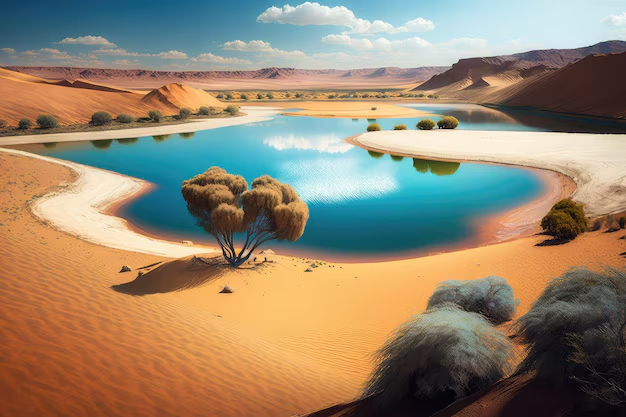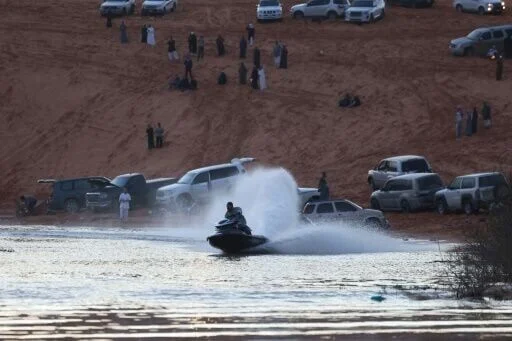Introduction
In the heart of Saudi Arabia’s arid landscape, an extraordinary seasonal transformation occurs each winter. Heavy rains give birth to temporary lakes, creating a stark contrast to the golden dunes that define the region. These rare bodies of water have become an unexpected attraction, drawing thrill-seekers, adventurers, and families to engage in watersports, particularly jet skiing. One such location, near the city of Zulfi, has turned into a hotspot for water enthusiasts, creating a surreal image of high-speed jet skis cutting across waters surrounded by endless sand dunes.
This phenomenon, which lasts for only a few months, is a spectacle of nature that highlights the ever-changing face of Saudi Arabia’s desert. It is also a testament to the country’s growing tourism sector, as both locals and international visitors flock to experience this one-of-a-kind aquatic playground in the middle of the desert.
How the Desert Lakes Form
Saudi Arabia is known for its dry, arid climate, but during the winter months, heavy rainfall can lead to the formation of ephemeral lakes in low-lying areas. These lakes can last anywhere from a few weeks to several months, depending on the volume of rainfall and evaporation rates. The lake near Zulfi, for example, emerges annually and remains for nearly three months before disappearing under the scorching desert sun.
These temporary lakes are not unique to Zulfi but have been spotted in other regions such as the Empty Quarter (Rub’ al Khali), Al Ahsa, and parts of central and northern Saudi Arabia. However, not all of these lakes become popular watersports hubs. The size, accessibility, and depth of the lake determine whether it can support recreational activities like jet skiing, kayaking, and swimming.
Watersports in the Desert: A Surprising Trend
With Saudi Arabia’s Vision 2030 initiative promoting tourism and recreational activities, watersports have found a growing fanbase in the country. The seasonal lakes provide an unexpected opportunity for jet ski enthusiasts to enjoy their passion in a completely unconventional setting.
Riders like Hamza al-Hamm, a local thrill-seeker, describe the experience as exhilarating. He recalls how he first started on a borrowed jet ski, instantly falling in love with the sport. Now, he owns his own machine and eagerly awaits the arrival of the seasonal lakes each year. For him and many others, this is a chance to break free from the monotony of the desert and indulge in high-speed aquatic action.

What makes the experience even more surreal is the juxtaposition of landscapes—powerful jet skis zooming across clear waters, framed by towering sand dunes. The contrast has captivated social media users, with videos of people enjoying the desert lakes going viral every season.
The Growing Popularity of Desert Lakes
The emergence of these lakes has drawn visitors from beyond Saudi Arabia, including neighboring countries like Kuwait, the United Arab Emirates, Bahrain, and Qatar. Many travel hundreds of kilometers just to witness the lakes firsthand and experience the thrill of watersports in a setting that seems almost impossible.
Take Meshaal al-Otaibi, for example, who journeyed over 700 kilometers from Taif to visit the seasonal lake near Zulfi. For him, the trip was about more than just adventure—it was about witnessing the rare beauty of nature in a land known for its dry climate.
Social media has played a significant role in increasing awareness about these lakes. Photos and videos of jet skiers racing across the water, families enjoying boat rides, and friends setting up picnics along the shore have encouraged more people to visit. What was once a secret known only to locals has now become a widely anticipated seasonal attraction.
Economic and Social Impact
The rise in popularity of these desert lakes has had a positive impact on the local economy. When the lakes appear, temporary markets spring up around them, with vendors selling food, drinks, and outdoor equipment. Rental businesses also thrive, offering jet skis, kayaks, and boats to visitors who do not own their own gear.
Families gather at the lakesides, turning the area into a lively social hub. Children splash in the water, groups of friends set up barbecues, and entrepreneurs see an opportunity to cater to the growing crowd. With tourism being a key focus for Saudi Arabia’s future, these natural attractions are a step toward diversifying the country’s leisure activities.
Local guides and tour operators have also started offering excursions to these lakes, providing transport, gear rental, and even photography services to capture the unique experience. As interest continues to grow, there are discussions about whether more formal infrastructure, such as designated recreational zones, should be introduced to manage crowds and maintain safety standards.
The Environmental Role of Temporary Lakes
Beyond recreation, these lakes serve an important ecological purpose. They temporarily replenish groundwater levels, benefiting surrounding vegetation and wildlife. Birds, both migratory and native, flock to these water sources, creating a temporary oasis in an otherwise harsh environment.
Species such as flamingos, ducks, and herons have been spotted near the lakes, making them an excellent site for birdwatching. In addition, small fish and amphibians sometimes appear, either transported by birds or emerging from dormant eggs that survive in the dry soil until the rains return.
However, as the lakes become more popular, conservationists stress the importance of responsible tourism. The sudden influx of visitors can lead to waste accumulation, pollution, and damage to fragile desert ecosystems. Efforts are being made to educate visitors about sustainable practices, ensuring that these seasonal wonders remain pristine for future generations.
Challenges and Future Considerations
While the lakes offer an exciting recreational opportunity, they also come with challenges. The rapid increase in visitors can strain local resources, and without proper management, the delicate balance between nature and tourism could be disrupted.
Authorities and local communities are working on solutions to address these concerns. Potential measures include designated parking areas, waste disposal facilities, and regulated water activities to ensure safety and environmental protection.
Another challenge is the unpredictability of these lakes. Since they depend on seasonal rainfall, some years they may not form at all, leading to uncertainty for those who plan trips and businesses around their appearance. This variability is part of what makes them special but also presents difficulties for long-term tourism planning.
Conclusion
The seasonal lakes of Saudi Arabia are a remarkable natural phenomenon that bring excitement, adventure, and economic benefits to the region. From the thrill of jet skiing in an unexpected oasis to the social gatherings that bring communities together, these lakes highlight the dynamic and evolving face of Saudi tourism.
As more people discover these hidden gems, the challenge will be to balance recreational enjoyment with environmental responsibility. If managed wisely, these temporary lakes could become a symbol of Saudi Arabia’s ability to embrace and promote nature’s surprises while preserving them for future generations.
For now, as winter rains arrive and lakes begin to form, jet skis will once again roar across the desert waters, creating an unforgettable experience for those lucky enough to witness this rare and breathtaking transformation.


